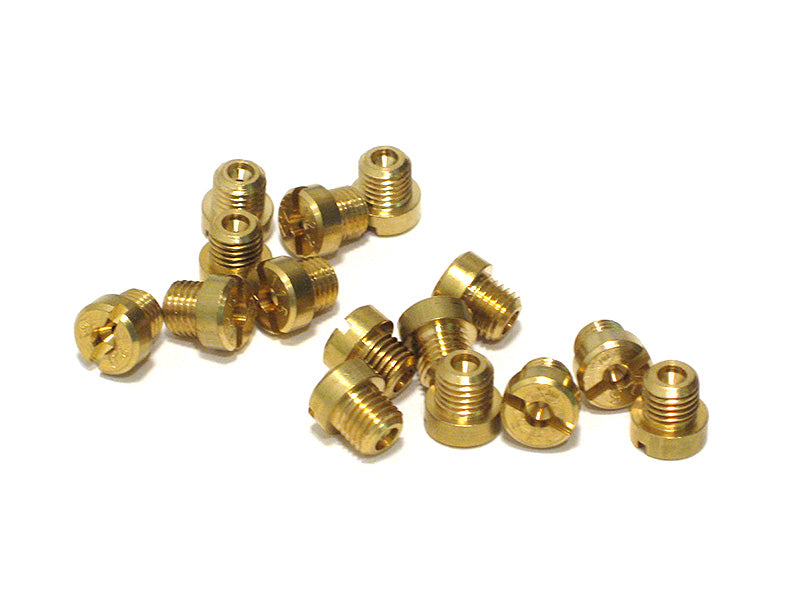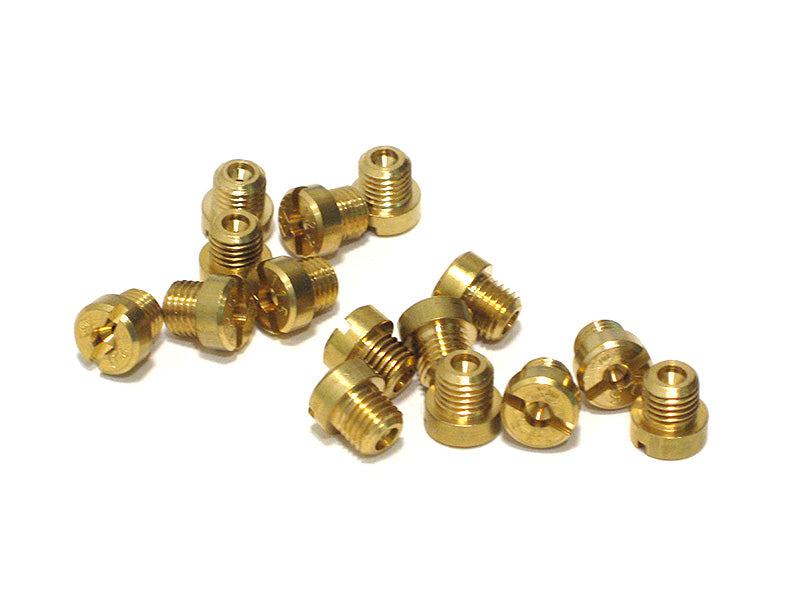Jetting
Jetting is critical and very sensitive to engine performance. Basically, you can go rich (more fuel/larger jet) and find power and torque down low in the rpm range. Or if you go lean (smaller jet/less fuel) and can find power up high in the rpm range but lose down low. It is a balancing act with an adjustment a fraction of the thickness of a sheet of paper making all the difference.
Jet Basics:
To get your jetting right you first need to make sure you have jets of various sizes. They come marked with a number like 56, 57, 58 but that is not a scale of size. The first thing you do is measure the jet orifice as this is critical to the amount of fuel the engine gets. This is done with a pin gage ranging from .022” to .026” in .0005” increments. Another way is with a microscope with measurement system but those can be hard to get access but will show you if the jet is round not oval. The rules say the jet cannot be bigger than .026” so make sure you are below that or you will get disqualified at any big race. If you are not sure take the jet to the tech official and ask him to check it with his jet gage. However, if you are running outlaw class somewhere you can get larger jets any size you need from us.
Measuring Jets:
Once you have the pin gages you can start measuring jet hole size. We typically have 4 or 5 jets in our tool box in increments of .0005”. The range we found most effect is .023” to .0257” and often end up around .025” plus or minus one size. You may find that 4 jets marked a certain number like 57 are actually different sizes. We see people changing jets all the time based on the number on the jet but not seeing the results they expect or any change at all. This is why you need to find jets by using a precision pin gage so each time you change a jet you see some sort of engine performance change. The other way to do this is dyno the motor with the jets you picked. This will resolve any issues where the jet hole may not be perfectly round as it really is about jet cross sectional area for fuel flow rate not pin gage size that fits. A matched dyno set is expensive to make but ensures you have a set of jets that actually make a change. If you need help contact us for a set of matched jets.
Correct Jet:
The correct jet will let the motor accelerate well from a dead stop but reach a good peak rpm. If you are too rich you will not run well at max rpm which can usually be heard as your driver comes by. If you are too lean the kart will take off slowly from a start and may not reach a higher rpm. From extensive testing we have found both lean and rich jets make the same Horsepower (HP) and Torque (TQ) around 8000 rpm. Lean jetting makes more power above 8000 rpm and richer makes more power below 8000 rpm. Don’t get caught up looking for super high rpm’s. That can hurt you more than help because you have less power coming off the turn or up small inclines. We had a motor turning an amazing 12500 rpm but was 1.5 seconds slower than a motor turning 11300 peak. The lower rpm motor was a huge advantage since it accelerated much faster to 11300 rpm then the high speed motor. Using a data acquisition system like AIM MyChron can clearly show you where on the track you are gaining or loosing time. At longer tracks where the min RPM seen in the slowest turn is high you may benefit from a leaner jet since you are probably above the 8000 rpm pivot point if your driver can carry speed in that turn. Other tracks where the low rpm may be 5500 you can benefit from a richer jet to get TQ off those slow turns. It may sound a little complicated at first but once you figure it’s not hard and don’t make it be. Your drivers skills often reduce lap times more than getting the perfect jet so again we suggest about a .025” jet and get all the driving time you can get to hone those driving skills.
Weather Effects:
Weather greatly affects what jet size you need with these little Comer C51’s. Every time we go on track we write down the atmospheric conditions including Relative Air Density (RAD), Humidity, Barometric Pressure, Elevation and Elevation Density for the time of day. We then try a jet and record how it works with these various weather conditions. This gives us a record of how the weather is affecting our motor. We have found RAD measurement to be very important and a simple indicator of jet needed. This measurement will range between 93 and 103 depending on the meter you have but the number is not as important as the change it makes during the day. A larger number means more fuel needed and a smaller one means less fuel needed. A common mistake is changing the jet at a race every time you go out and trying to be fast in the morning and the afternoon. Actually, you want to be fast at race time so chasing the right jet throughout the morning and having the wrong jet for your race in the afternoon is not helpful. We also have found Elevation Density to operate the same way so watch that carefully too.
Effect of Oil:
You really can change jetting needed by changing that amount of oil per gallon in your mixture. We like a higher oil ratio like 9 oz per gallon of your favorite oil. However, from our testing dropping from 9 oz to 8 oz of oil per gallon requires one less jet size to get similar power since there is more fuel in the 8 oz mixture. Some series are now adding limits to range of oil so check with the rules to see what you can run. Again, more oil usually needs a bigger jet and less oil usually a smaller jet.
Storing Jets:
Now that you took all this time and effort to get perfect jets you need to take very good care of them. The hole dimension between jet sizes is 1/8 the thickness of a human hair. ANY dirt or oil film will ruin your day so we keep them in a jet caddy, in a ziplock bag, in a small sealed plastic container. Clean them every day you use them and check them with your pin gage occasionally.

Precision Karting Technologies, LLC
PKT Pinned Comer Jet Set
Product Details
PKT Pinned Comer Jet Set
Wixom, MI
28718 Wall Street
Wixom MI 48393
United States

Precision Karting Technologies, LLC
Comer Outlaw Jets
Product Details
Comer Outlaw Jets
60
Wixom, MI
28718 Wall Street
Wixom MI 48393
United States
